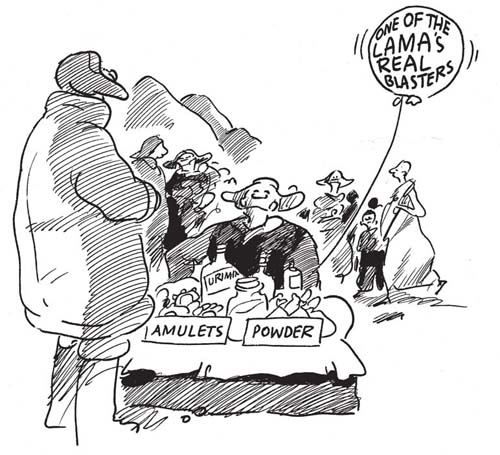Disgraceful Archaeology (8 page)
Read Disgraceful Archaeology Online
Authors: Paul Bahn

According to Pliny, the Scythians preferred mares for the purposes of war because they can pass their urine without stopping in their career.
Early travellers among the Chukchi of Siberia reported that they offered their women to the travellers, but the latter had to show themselves worthy by undergoing a disgusting ordeal — the girl or woman who was to spend the night with the guest presented him with a cup of her urine, and he had to rinse his mouth with it. If he was brave enough to do this, he was considered a sincere friend; if not, an an enemy of the family.
The Chukchi used to pretend to be passing urine in order to catch their animals which they wanted to use with their sleds. The reindeer, horses and cattle of the Siberian tribes are very fond of urine, probably because of the salt it contains, and when they see a man walking out from the hut, as if for the purpose of relieving his bladder, they follow him up so closely that he finds the operation anything but pleasant.
The dogs of the Eskimo are equally fond of excrement, especially in cold weather, and when a resident of the Arctic desires to relieve himself, he finds it necessary to take a whip or stick to defend himself against the energy of the hungry dogs. Often, when a man wants to urge his dog-team to greater exertion, he sends his wife or one of the boys to run ahead, and when at a distance, to stoop down and make believe they
are relieving themselves. The dogs are thus spurred to furious exertion, and the boy runs on again, to repeat the delusion. This never fails of the desired effect, no matter how often repeated (
34
).

34
Divination: The ancient Peruvians had one class of ‘wizards’ who ‘told fortunes by maize and the dung of sheep’, while eighth-century Europe also had pagan superstitions involving divination or augury by the dung of horses, cattle or birds.
Among the superstitious practices of the Greeks, Plutarch mentions ‘rolling themselves in dung-hills’, ‘foul expiations’, ‘vile methods of purgation’, ‘bemirings at the temple’, with ‘penitents wrapped up in foul and nasty rags’ or ‘rolling naked in the mire’.
The Romans and Egyptians had gods of excrement, whose special function was the care of latrines and those who frequented them. According to the eighteenth-century Spanish author
Torquemada, the Egyptians ‘used to adore stinking and filthy privies and water-closets .… and they adored the noise and wind of the stomach when it expels from itself any cold or flatulence.’ The Romans also venerated latrines, and made sacrifices to them. The Roman goddess was called Cloacina, one of the first of the Roman deities, believed to have been named by Romulus himself. Under her charge were the various cloacae, sewers, privies, etc. There was also a god of ordure named Stercutius; one for other conveniences, Crepitus.

35
Several seventeenth-century travellers to Tibet reported that the grandees of the kingdom were very anxious to procure the excrements of the Grand Lama, which they usually wore about their necks as relics, in the form of amulets or as powder in bags;
and they mixed his urine with their victuals, imagining this would secure them against all bodily infirmities (
35
).
It was forbidden to commit desecration — the Romans had inscriptions warning of the wrath of the twelve great gods, and Jupiter and Diana too, against all who did any indecency near temples or monuments. The Emperor Caracalla put to death those who urinated in front of his statues.
The Assyrians’ Venus had offerings of dung placed upon her altars, while their neighbours, the Israelites and Moabites, had a similar ceremonial in their worship of Bel-phegor (see above, p.62). The devotee presented his naked posterior before the altar and relieved his bowels, making an offering to the idol of the foul emanations. All the outward orifices of the body were presented to the idol, as well as all their emanations or excretions: tears from the eyes, wax from the ears, pus from the nose, saliva from the mouth, and urine and dejecta from the lower openings (
36
).

36
The Mexicans had a goddess, Suchiquecal, the mother of the human race, depicted in a state of humiliation, eating ordure; another goddess, Tlacolquani, was also an eater of ordure because she presided over loves and carnal pleasures, and heard and pardoned the confessions of men and women guilty of unclean and carnal crimes.
Herodotus said that Egyptian women urinated standing up, and men sitting down. They relieved themselves indoors and ate outside. It is said that Apache men also urinated sitting down, but the women did it standing up. The same has also been said of the Mojaves of the Rio Colorado, and of some Australian Aboriginal tribes (
37
).
A genuine Pompeii graffito —
Hac ego cacavi
— I had a shit here (
38
).

37

38
From ancient Cyprus, a seventh-century BC jug from Karpass, now in the British Museum, shows a ship carrying two large storage jars. A man squats on one of the two steering oars, and defecates towards a large fish.
The Chumash of California had a somewhat dirty ‘coyote dance’ — the dancer was a single man, impersonating the coyote. He sang ‘The devil goes ahead. The tail swishes, so that the hunk of crap remains here on the ground.’ During the last part of the song, he was trying to persuade someone to come over to lick his penis for him; but by the last verse, he had lost all hope and so did it himself. The last part of the song meant to swing your tail so that you would be able to defecate, and the dung would remain there for the coral snake. He continued: ‘Do not distrust me. All this shit piled high — I have crapped it all’. With the last verse, the coyote licked his penis. Then: ‘Do not think me arrogant — Everything that is piled up here is my crap.’ As he began to sing this last verse, he loosened his garment, and when finished, he squatted down and defecated amid the people. The dancer took a drink of seawater in the morning so that when this part of the dance came he could crap on cue.
A Javanese rock-shelter near Kadiri, whose decoration dates to the eleventh century AD, shows a story from the Arjunawiwaha. Arjuna is practising asceticism — the gods send down two heavenly nymphs to test his resolve and the strength of his meditation by wrapping themselves around him. He passes the test, and so receives the two nymphs as his wives. For some obscure reason, the carving shows one nymph relieving herself in a stream.
Down to the early fifth century BC, Greek painters sometimes portrayed disgusting subjects on vases: a man wiping his anus, an explosion of diarrhoea at a party, copious drunken vomiting. In one, a squatting youth simultaneously urinates and defecates on the ground, and the painter has made his penis loll to one side lest our view of the faeces be obscured. On another vase, a man reclines on each side, happily masturbating, while under each handle a dog defecates.
Diocles, a Roman charioteer, had one horse that had won over 200 races. This horse, named Passerinus, was so revered that soldiers patrolled the streets when he was sleeping to keep people from making any noise. When a rumour went around that Passerinus had been doped by rivals, people hurried to the stable to taste his dung to see if it were true.
Most Roman charioteers coated themselves with boar’s dung in the belief that the odour kept the horses from stepping on a man if he was thrown from his chariot. And the professional chariot-racers of ancient Rome were encouraged to promote muscle-growth by drinking a solution of dried boar’s dung (
39
).
Wild animals were on display at the Tower of London in the seventeenth century — one visitor, Ned Ward, wrote of ‘a leopard who is grown as cunning as a cross Bedlamite that loves not to be looked at. For as the madman will be apt to salute you with a bowl of chamber-lie, so will the leopard, if you come near him, stare in your face and piss upon you, his urine being as hot as aqua fortis and stinks worse than a polecat’s.’
A scene on a Greek potsherd shows a caricature of a shitting man, about to wipe himself with one hand and holding his nose with the other. His circumcised, droopy penis reaches down almost to his heels.
Other Greek vases depict a harlot urinating into a chamber pot; a satyr having sex with a startled-looking doe; older prostitutes being penetrated orally and anally at the same time.

